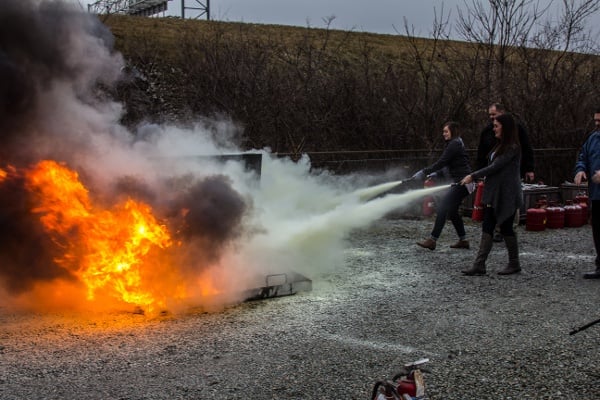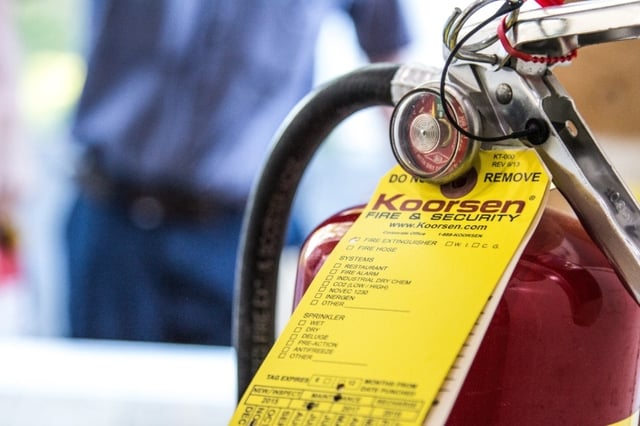
When a fire starts and you finally need to use that fire extinguisher that you pass in the hall every day, that’s not the time to discover you don’t know how to use it properly.
“Something is better than nothing” does not apply here. Using a fire extinguisher does no one any good if used incorrectly.
Fire extinguishers do take a bit of know-how to use effectively and safely to put out a fire. They are simple, but in an emergency situation, for many people, simple can become complicated or confusing.
This is why it is so important to: first of all, know where fire extinguishers are located in your building, and second of all, review its proper use so that if and when it is needed, it actually works.
How Fires Work
First, to understand proper use of a fire extinguisher, it helps to have a basic understanding of fire.
All fires, regardless of their class (more on that in a moment) have the same four elements:
- Fuel
- Heat
- Oxygen
- Chain Reaction
If any one of these four elements is removed, the fire will die. The goal of fire extinguishers, then, is to remove one or more of these elements through the extinguishing media.
However, it is important to remember that there are different types of fire extinguishers for the various classes of fire. To be effective, you need to choose the right fire extinguisher for the type of fire you are dealing with, if that is an option.
As a quick review, the classes of fire are:
- Class A: combustible materials such as paper or wood
- Class B: liquid or gas fire
- Class C: energized electrical fire
- Class D: metallic fire
- Class K: grease / cooking fire
Important Note: Regardless of the type of fire, the source of the actual burning is at the base of the fire, not the flames in the air. This will be important to remember in a moment when reviewing the PASS method of using a portable fire extinguisher.
Each fire extinguisher is labeled to indicate the class of fires it can be used for.
If the right type of extinguisher is not available, evacuate the area and call the fire department. Do not attempt to use the wrong extinguisher on the fire.

How To Use An Extinguisher – The PASS Method
Now that you have a reminder of the four elements of fire and their classes, it’s time to review the proper use of a portable fire extinguisher, which can be remembered easily as the PASS method.
Using a fire extinguisher requires just four easy steps, each represented by a letter in the word PASS:
- Pull the pin: every fire extinguisher has a safety pin to prevent accidental discharge of the extinguishing media during handling. There is also a safety tie keeping the pin in place. The fire extinguisher cannot discharge until this pin is removed.
So the first step is to pull the pin out of the extinguisher.
It helps to use a twisting motion while you pull, so that the safety tie is broken, making it easier to remove the pin.
- Aim the hose at the base of the fire: as mentioned above, the source of the burning is the base of the fire, where the oxygen is hitting the fuel and heat and where the chain reaction is taking place.
If you aim at the flames, the extinguishing media will fly over the burning material to the other side and be rendered useless.
So, from a safe distance, aim the hose at the base of the fire.
- Squeeze the handle: once you are aiming at the base of the fire, squeeze the handle of the fire extinguisher to discharge the extinguishing media.
A word of caution: if you are using a CO2 extinguisher, avoid touching the discharge nozzle, as there is risk of getting frost-bite.
- Sweep: sweep from side to side over the base of the fire as you slowly approach. This ensures that all of the burning material is covered with the media. Be cautious not to get close or to stand on the previously burning area, as it can reignite.
It is as simple as that.
Deciding To Use An Extinguisher
IMPORTANT: If you have any doubts about your ability to use a fire extinguisher or unsure about the fire, evacuate the facility immediately.
If you should choose to use a fire extinguisher to fight a fire, you should only attempt using a fire extinguisher to put out a fire if:
- the fire is in its early, incipient stage
- you have the right fire extinguisher for the class of fire
- you have a safe exit path
If the extinguisher should run out of media before the fire is put out, exit immediately, and should the fire develop past an early stage, don’t keep trying to fight the fire – head for safety.
Training For Your Employees
If you are an employer and you have provided fire extinguishers for use in a fire, you are responsible for the training of your employees. It is important, and required for OSHA, that they be trained on an annual basis and that new employees be trained when they start.
Koorsen Fire & Security
provides hands-on training classes for businesses so that everyone is trained in fire safety and the proper use of fire extinguishers. The opportunity to get hands-on experience will help your employees feel more confident and stay safe in the event of an actual fire, making this method far better than a simple classroom discussion.
If you and your team are in need of training or are due for a refresher, give Koorsen a call today!



